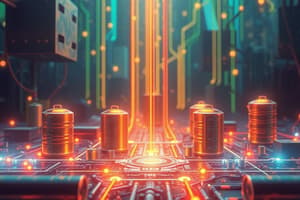Podcast
Questions and Answers
What are the learning competencies related to capacitance and capacitors discussed in the text?
What are the learning competencies related to capacitance and capacitors discussed in the text?
Understanding the concept of capacitance, analyzing capacitors in series and parallel, applying mathematical formulas, applying concepts to real-world applications.
What are the learning objectives regarding capacitance mentioned in the text?
What are the learning objectives regarding capacitance mentioned in the text?
Identify factors affecting capacitance, differentiate between series and parallel capacitors, calculate equivalent capacitance, apply principles to solve practical problems.
What is the motivation provided in the text related to capacitance and capacitors?
What is the motivation provided in the text related to capacitance and capacitors?
Game rules involving arranging jumbled words for points.
How are capacitors connected in series different from those connected in parallel?
How are capacitors connected in series different from those connected in parallel?
What is the significance of calculating total capacitance in series and parallel circuits?
What is the significance of calculating total capacitance in series and parallel circuits?
How can the principles of capacitance be applied to real-world applications?
How can the principles of capacitance be applied to real-world applications?
What is the formula for the capacitance of a spherical capacitor?
What is the formula for the capacitance of a spherical capacitor?
What is the formula for the potential difference between two concentric cylinders in a cylindrical capacitor?
What is the formula for the potential difference between two concentric cylinders in a cylindrical capacitor?
Calculate the capacitance of a spherical capacitor with ra = 0.03 m and rb = 0.06 m, if ϵ₀ = 8.85 x 10^-12 F/m.
Calculate the capacitance of a spherical capacitor with ra = 0.03 m and rb = 0.06 m, if ϵ₀ = 8.85 x 10^-12 F/m.
In a cylindrical capacitor, what does Q represent?
In a cylindrical capacitor, what does Q represent?
What is the electrostatic constant ϵ₀ in the context of capacitors?
What is the electrostatic constant ϵ₀ in the context of capacitors?
Explain the construction of a cylindrical capacitor.
Explain the construction of a cylindrical capacitor.
What is the formula for the magnitude of the electric field in a parallel-plate capacitor?
What is the formula for the magnitude of the electric field in a parallel-plate capacitor?
How is the capacitance of a parallel-plate capacitor related to the plate area and plate separation?
How is the capacitance of a parallel-plate capacitor related to the plate area and plate separation?
What does the voltage (V) across a capacitor represent?
What does the voltage (V) across a capacitor represent?
What happens to the charge storage capacity of a capacitor if the plate area is increased?
What happens to the charge storage capacity of a capacitor if the plate area is increased?
How does the distance between the plates affect the attraction between the oppositely charged plates in a capacitor?
How does the distance between the plates affect the attraction between the oppositely charged plates in a capacitor?
What is the constant called that is related to the permittivity of free space in a parallel-plate capacitor?
What is the constant called that is related to the permittivity of free space in a parallel-plate capacitor?
What does ε₀ represent in the context of a cylindrical capacitor?
What does ε₀ represent in the context of a cylindrical capacitor?
What does the symbol 'ln' represent in the context of the given text?
What does the symbol 'ln' represent in the context of the given text?
What does rb represent in the formula for a cylindrical capacitor?
What does rb represent in the formula for a cylindrical capacitor?
In the example provided, what is the length of the cylindrical capacitor?
In the example provided, what is the length of the cylindrical capacitor?
What is the formula for capacitance in the context of a cylindrical capacitor?
What is the formula for capacitance in the context of a cylindrical capacitor?
How can a resistor be utilized in an electrical circuit?
How can a resistor be utilized in an electrical circuit?
What is the formula for calculating capacitance in a circuit?
What is the formula for calculating capacitance in a circuit?
Define the term 'Capacitance'.
Define the term 'Capacitance'.
Explain the difference between a parallel-plate capacitor and a spherical capacitor.
Explain the difference between a parallel-plate capacitor and a spherical capacitor.
What is the key difference between components in a series circuit and a parallel circuit?
What is the key difference between components in a series circuit and a parallel circuit?
How can you calculate total capacitance in a parallel connection of capacitors?
How can you calculate total capacitance in a parallel connection of capacitors?
What is the equation for charge in a series connection of capacitors?
What is the equation for charge in a series connection of capacitors?
Flashcards are hidden until you start studying
Study Notes
Capacitance and Capacitors
- Capacitance is the ability of a capacitor to store electrical charge.
- Capacitors are devices that store electrical charge.
Factors Affecting Capacitance
- Plate area: larger plate area allows for more charge storage.
- Plate spacing: smaller plate spacing allows for more charge storage.
- Dielectric material: affects the ability of a capacitor to store electrical charge.
Types of Capacitors
- Parallel-plate capacitor: consists of two parallel conducting plates.
- Spherical capacitor: consists of two concentric spheres.
- Cylindrical capacitor: consists of two concentric cylinders.
Capacitor Formulas
- Capacitance (C) = Q / V, where Q is the charge and V is the voltage.
- Parallel-plate capacitor: C = ε₀A / d, where ε₀ is the permittivity of free space, A is the plate area, and d is the plate spacing.
- Spherical capacitor: C = 4πε₀ / (1/ra - 1/rb), where ra is the radius of the inner sphere and rb is the radius of the outer sphere.
- Cylindrical capacitor: C = (2πε₀L) / ln(rb / ra), where L is the length of the cylinders and ra and rb are the radii of the inner and outer cylinders.
Circuit Types
- Series circuit: all components are connected end-to-end.
- Parallel circuit: all components are connected across each other.
Series and Parallel Circuit Formulas
- Series connection: C = (C1⁻¹ + C2⁻¹ + ... + Cn⁻¹)⁻¹, where C1, C2, ..., Cn are the capacitances of the individual capacitors.
- Parallel connection: C = C1 + C2 + ... + Cn, where C1, C2, ..., Cn are the capacitances of the individual capacitors.
Sample Problems
- Example 1: Spherical capacitor with an inner radius of 5 cm and an outer radius of 10 cm, filled with air. Calculate the capacitance.
- Example 2: Cylindrical capacitor with an inner radius of 3 cm, an outer radius of 6 cm, and a length of 8 cm. Calculate the capacitance.
Studying That Suits You
Use AI to generate personalized quizzes and flashcards to suit your learning preferences.





